Restaurant app development trends are reshaping how the food industry connects with customers in 2025.
From quick online orders to personalized dining experiences, mobile apps are now the heart of restaurant growth strategies.
With the rise of latest technology trends like AI, machine learning, and contactless payments, restaurants are going beyond just food, they're offering convenience and innovation.
Whether you’re upgrading an existing app or planning a new one, staying updated on the current trends in restaurant app development can give you a major competitive edge. So, let’s explore the innovations driving the future of dining.
What is the Restaurant App?
A restaurant app is a mobile app designed to streamline and enhance the dining experience for both customers and restaurant owners.
These apps offer a wide range of features, such as online food ordering, table reservations, real-time menus, digital payments, customer reviews, and loyalty programs.
Whether it’s a dine-in restaurant, cloud kitchen, or fast-food outlet, having an app helps manage operations efficiently while offering customers more control and convenience.
Restaurant apps also allow businesses to gather valuable customer data, send personalized offers, and maintain strong brand engagement, all from a single digital platform.
If you're planning to develop a restaurant app, understanding the key features and market statistics is the first step to building something truly impactful.
Market Statistics of Restaurant App
The restaurant app industry is experiencing significant growth, driven by evolving consumer preferences and technological advancements.
Understanding these trends is crucial for businesses aiming to stay competitive.
-
According to Grand View research, in 2024, the global restaurant management software market was valued at $ 5.79 billion and is expected to grow at a CAGR of 17.4% between 2025 and 2030.
-
Statista research suggests the online food delivery market is expected to generate revenue of approximately $1.39 trillion in 2025.
-
More apps are leveraging AI to tailor recommendations, personalize menus, and enhance user experience, making dining decisions smarter and faster.
-
A report by Market.us shows that the global restaurant digitalization market is projected to reach approximately $ 37.0 billion by 2033, up from $ 7.9 billion in 2023, growing at a CAGR of 16.7% between 2024 and 2033.
-
From dark mode to minimalistic UI, app design trends are focused on comfort, accessibility, and aesthetic appeal.
These statistics underscore the importance of staying abreast of Restaurant App Development Trends to capitalize on the industry's growth and meet consumer demands effectively.
Adapting to these trends not only enhances user satisfaction but also positions your brand as a forward-thinking leader in the digital dining space.
Top Trends of Restaurant App
Keeping up with restaurant app development trends is crucial in today’s tech-savvy food industry. With changing customer behavior and evolving digital tools, restaurants need to adapt quickly.
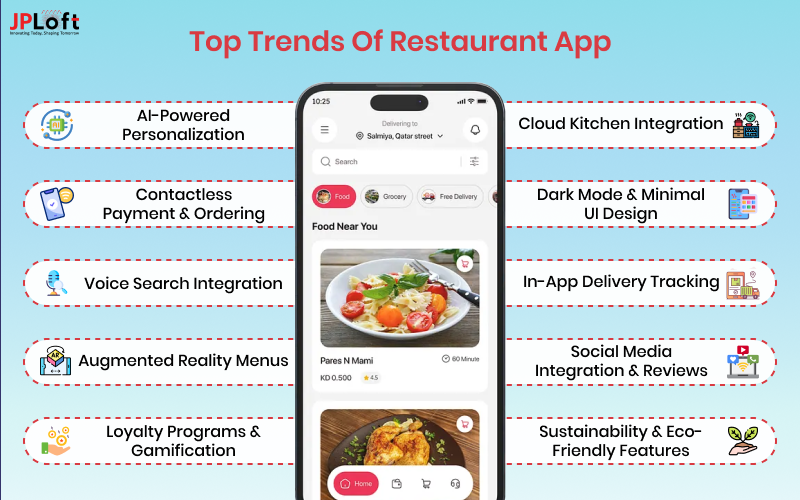
Let’s explore the top trends of restaurant app development that are shaping 2025 and beyond.
1. AI-Powered Personalization
AI is becoming a game-changer among restaurant app trends. It makes apps learn users' behavior and make suggestions better, like recommending favorite foods or personalized offers. It offers an engaging experience and boosts loyalty.
It’s one of the current trends in restaurant app development that truly enhances the user journey. With the rise of AI app development, restaurants can now build smarter, data-driven apps that adapt to customer preferences in real time.
This personalized touch not only delights users but also drives higher conversion rates and repeat business.
2. Contactless Payment & Ordering
Good hygiene and ease of use are more necessary than ever, and contactless options satisfy both. This restaurant app development trend allows users to browse menus, order, and pay, never touching a physical menu or cash.
It's quick, safe, and becoming the standard for contemporary patrons. No wonder it’s one of the leading technological trends of restaurant app interfaces. This seamless, touch-free experience not only boosts customer confidence but also streamlines operations for restaurants.
3. Voice Search Integration
With voice assistants becoming ubiquitous, voice search is now a prominent feature in apps. This is the emerging trend for restaurant apps that allows users to order or search for food hands-free.
It's particularly convenient for customers on the move or who prefer talking over typing. It also makes your app appear more futuristic and user-centric. As voice technology evolves, integrating it early can give your app a competitive edge in the crowded food-tech space.
Embracing voice search now sets the stage for smoother, more intuitive interactions in the future of restaurant apps.
4. Augmented Reality (AR) Menus
AR (Augmented Reality) is changing how customers relate to food imagery. This next-generation restaurant trend allows users to view 3D images of dishes before ordering, building confidence in choices and enhancing the dining experience.
VR (Virtual Reality) is also making its way in, offering immersive virtual tours of restaurant interiors or even live kitchen views. These interactive elements not only captivate users but also elevate your brand.
With the rise of AR VR app development, integrating such features is becoming more accessible and impactful for businesses aiming to stand out in a competitive market.
5. Loyalty Programs & Gamification
Basic rewards are giving way to interactive loyalty systems. Users now earn points through login frequency, games, or referral challenges. These features capture increasing restaurant app trends for businesses that want to retain users longer.
It's a clever combination of fun and functionality, aligned with leading restaurant app market trends. Such engaging loyalty systems not only boost user retention but also encourage repeat orders through personalized incentives.
6. Cloud Kitchen Integration
Cloud kitchens are on fire, and so is the demand for apps to facilitate them. One app can now handle several virtual restaurant brands and menus. This trend improves backend efficiency and order fulfillment.
It's an emerging trend for restaurant apps designed for new business models. As cloud kitchens grow, integrating them smartly into your app becomes essential to stay competitive and scalable in the evolving food delivery space.
7. Dark Mode & Minimal UI Design
In terms of design trends in restaurant app development, simplicity is winning. Dark mode, minimalistic layouts, and easy navigation improve user experience while appearing trendy. A nicely designed app makes it a pleasure to browse and indicates a brand's professionalism.
Such visual aspects are now a standard in next-generation food apps. These design choices not only reduce eye strain but also help your app stand out with a sleek, modern look that users appreciate.
8. In-App Delivery Tracking
Customers adore knowing just where their meals are. Real-time GPS tracking within the app creates trust and adds transparency. More transparency equals less complaining and more repeat business.
While features like this can also influence the cost to develop a restaurant app, depending on the complexity of tracking and integration. It's one of the most important features of restaurant apps that drive customer satisfaction.
9. Social Media Integration & Reviews
Users today need to share, review, and recommend, all within the app. Both social media platforms integration and in-app reviews enable a dynamic user space.
Such restaurant app development trends increase visibility and trust. Social engagement also aids in organic marketing. This not only builds a loyal community but also turns your customers into brand advocates effortlessly.
10. Sustainability & Eco-Friendly Features
Green is the new favorite. Apps now display recyclable packaging information, provide digital receipts, and environment friendly decisions. These represent both customer values and expanding restaurant app market trends. It's a considerate gesture that differentiates your app in an oversaturated market.
As sustainability becomes a priority for modern diners, integrating such features can boost brand reputation and customer loyalty. It’s more than a feature, it’s a statement of values that today’s users appreciate.
But before jumping into restaurant app development trends, it’s important to be aware of potential restaurant app development challenges like rising costs, feature overload, or data privacy issues.
By following these trends while creating a restaurant app, you can deliver something innovative, useful, and future-ready.
How Best Restaurant Apps Are Leveraging Industry Trends?
Some of the best restaurant apps are smartly riding the wave of emerging tech and customer preferences. From AI personalization to dark mode designs and cloud kitchen support, each leading app is setting a benchmark in its own way.
Let’s explore what they’re doing right-
|
App Name |
Trends that These Apps Follow |
|
Starbucks |
Integrates AI-powered personalization and gamified loyalty programs. Users get tailored drink recommendations and earn rewards through challenges, aligning with restaurant app development trends. |
|
DoorDash |
Offers real-time delivery tracking and voice search integration, creating a user-first experience while embracing technological trends of restaurant apps. |
|
Chick-fil-A |
Uses clean, minimal UI with dark mode and smooth navigation. Their app reflects modern design trends in restaurant apps for better accessibility. |
|
Uber Eats |
Supports multiple cloud kitchens and virtual brands. Their backend tech matches current trends in restaurant apps by improving speed and efficiency. |
|
Taco Bell |
Introduced AR menu previews and exclusive in-app deals. It's diving into AR VR apps to deliver immersive and next-gen ordering. |
|
Panera Bread |
Focuses on sustainability with digital receipts and reusable packaging info, tapping into the rising restaurant app market trends. |
|
Grubhub |
Leverages social integration and in-app reviews for community-driven trust, syncing well with restaurant app development trends. |
|
Chipotle |
Employs AI for personalized menu suggestions and contactless ordering, enhancing convenience and aligning with restaurant app development trends. |
|
Sweetgreen |
Emphasizes eco-friendly features like recyclable packaging info and digital receipts, supporting sustainability trends in restaurant apps. |
|
Caviar |
Provides real-time delivery tracking and integrates voice search, improving transparency and user experience according to the latest restaurant app trends. |
These apps are proof that the trends in restaurant apps isn’t just a trend, it’s a strategy. By aligning with the latest technology trends they’re offering smoother, smarter, and more personal experiences.
Tips to Future-Proof Your Restaurant App
The restaurant app market is evolving fast and to stay ahead, you need to build an app that’s ready for the future. It’s not just about trends today, but how your app grows and adapts tomorrow.
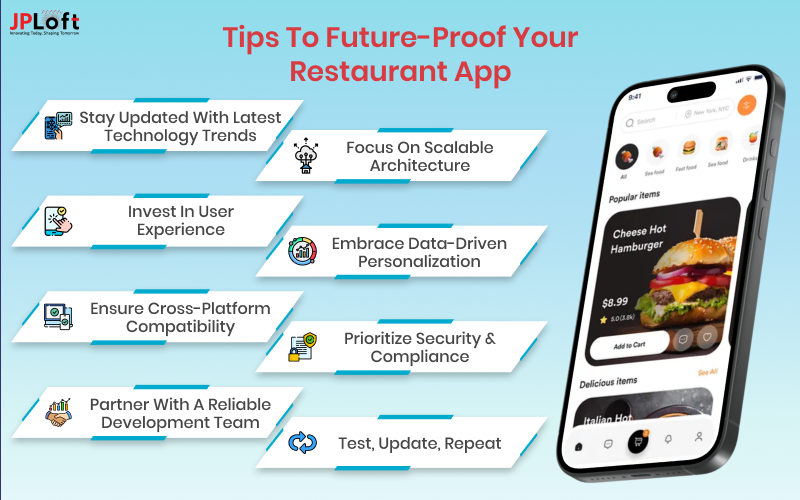
Here are a few practical tips to help you stay ahead of the curve:
-
Stay Updated with Latest Technology Trends: Regularly upgrade your app to align with the latest technology trends like AI, AR/VR, and cloud integration. Staying current ensures your app doesn’t fall behind.
-
Focus on Scalable Architecture: Build your app in a way that it can handle growth like more users, more features, and more restaurants without performance issues.
-
Invest in User Experience (UX): Keep your interface intuitive and clutter-free. Following the design trends in restaurant app development like minimal UI and dark mode can greatly enhance user satisfaction.
-
Embrace Data-Driven Personalization: Use AI to analyze customer preferences and behavior. This lets you offer smart suggestions, boosting engagement and loyalty.
-
Ensure Cross-Platform Compatibility: Your app should work seamlessly across iOS, Android, tablets, and even wearables. This widens your audience reach.
-
Prioritize Security & Compliance: Use secure payment gateways, follow data protection laws, and be transparent about user data usage to build trust.
-
Partner with a Reliable Development Team: Collaborate with an expert mobile app development company in Denver that understands industry-specific needs and can integrate the key trends in restaurant app development efficiently.
-
Test, Update, Repeat: Regularly test your app, fix bugs, gather user feedback, and keep improving. To stay ahead in restaurant app development trends, app testing is important.
By implementing these strategies, your restaurant app will be ready to thrive. Staying progressive with these future-proofing tips ensures long-term success and stronger user connections.
Develop a Restaurant App with JPLoft – Powered by Innovation
Got an idea of a standout restaurant app? Let JPLoft turn it into a reality flawlessly. As a top-rated restaurant app development company, we specialize in building feature-rich, trend-driven apps that your customers will appreciate.
Whether you're aiming for AI personalization, AR menus, or cloud kitchen integration, our expert developers are already ahead of the curve. We focus on the latest technologies and user-friendly design that ensures your app isn’t just functional, it’s future-ready.
So, whether you're a startup or an established restaurant looking to upgrade, partner with us to bring your vision to life. Let’s create an amazing digital experience together.
Final Wrap-Up
Staying ahead in the competitive food industry means embracing the latest restaurant app development trends. From AI personalization to cloud kitchen integration, these trends are reshaping how restaurants connect with customers and streamline their services.
By understanding and implementing these innovations, businesses can create apps that not only attract users but also build lasting loyalty. Whether you’re just starting or looking to upgrade your existing app, keeping up with these trends is key to success.
So, dive into the future of restaurant apps and make your digital presence truly stand out. Embracing these trends also ensures your app stays relevant in a fast-evolving market, where user expectations and tech innovations shift rapidly. The sooner you adapt, the stronger your competitive edge becomes.
FAQs
The latest trends include AI-powered personalization, voice search integration, AR menus, cloud kitchen support, and gamified loyalty programs, all designed to enhance user experience and streamline operations.
Keeping up with the latest trends helps your app stay competitive, meet evolving customer expectations, and leverage new technologies for better engagement and revenue growth.
Trends like minimal UI design, in-app delivery tracking, and social media integration create a seamless, engaging, and interactive experience that keeps users coming back.
AI analyzes user behavior to offer personalized recommendations, optimize menu suggestions, and deliver targeted promotions, making the app more engaging and customer-friendly.
Businesses are leveraging trend-based features like cloud kitchen support, gamification, and personalized offers to increase customer satisfaction, reduce costs, and drive revenue.





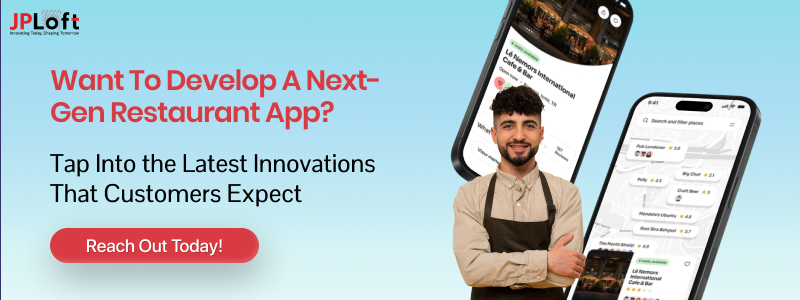
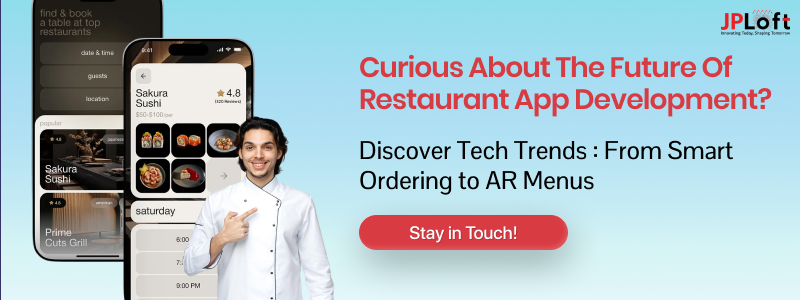

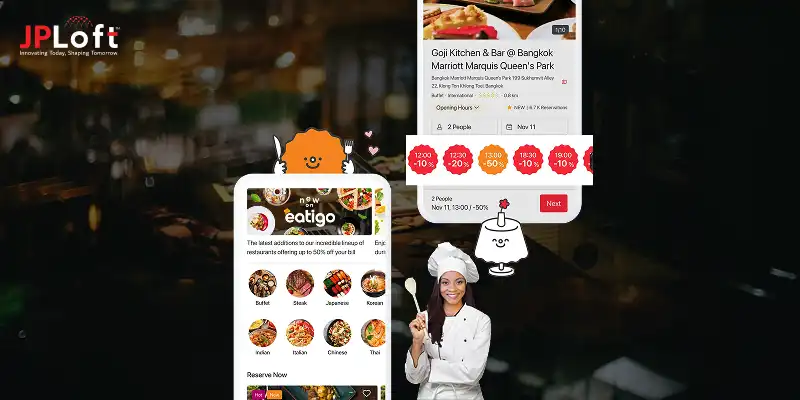

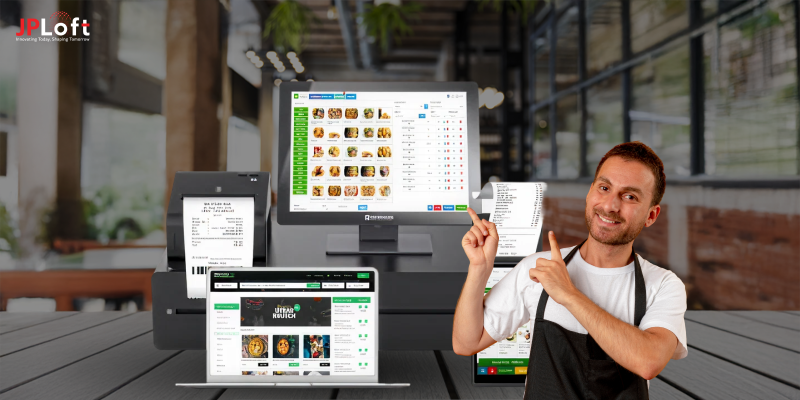


Share this blog